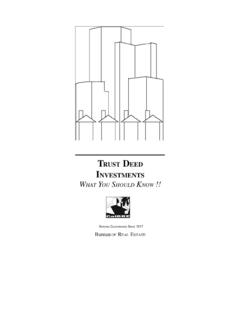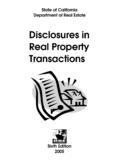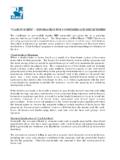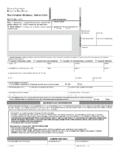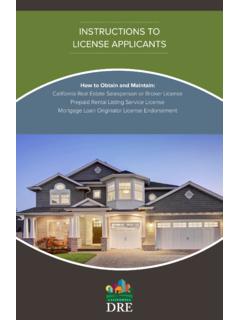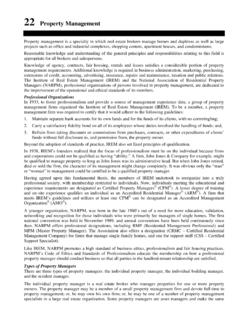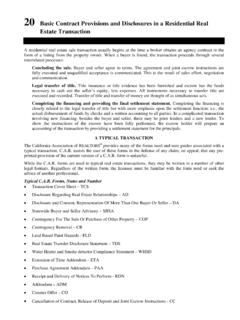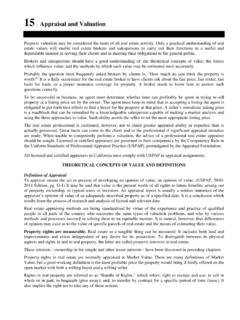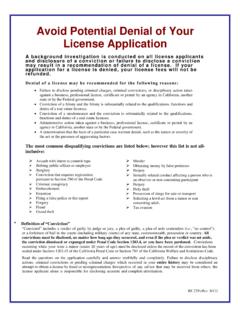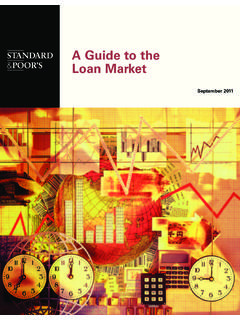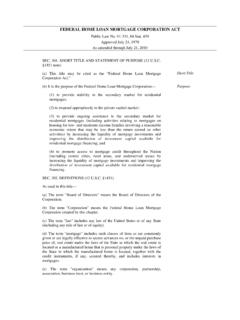Transcription of 1. Title Page - California Bureau of Real Estate
1 12 Real Estate Finance BACKGROUND Finance is the lifeblood of the real Estate industry. Developers, contractors, real Estate brokers (REBs) and mortgage loan brokers (MLBs) should each understand how real Estate is financed. Traditional sources of loan funds are the financial depository institutions (depository institutions), including savings and loan associations, savings banks, commercial banks, thrift and loans and credit unions. Other non-institutional sources characterized as non-banks include mortgage bankers, finance lenders, private individuals and entities, pension funds, mortgage trusts, investment trusts, and hedge funds. Insurance companies are neither depository institutions nor non-banks. These entities collect premiums from policyholders/the insured and invest some of the premium dollars in interests in real property, including equities and mortgage loans.
2 Brief Overview Over the past 15 to 20 years, enacted California legislation that characterized certain non-depository institutions or non-banks as institutional and supervised lenders for limited, defined purposes. These include mortgage bankers (licensed under the Residential Mortgage Lending Act), finance lenders (licensed under the California Finance Lender Law), pension funds in excess of $15,000,000 in assets, mortgage trusts, investment trusts, and hedge funds. The expansion of these non-depository institutions or non-banks and their growing share of the residential mortgage market resulted in the development of a secondary market through securitization of mortgage loans in the form of mortgage backed securities. Mortgage backed securities are qualified by registration for intrastate and by coordination for interstate issuance of public offerings.
3 Depending upon the fact situation, these securities may also be qualified by exemption as private placements in accordance with applicable federal and state law. The secondary mortgage market (investors purchasing real Estate loans originated by other lenders through mortgage backed securities) surpassed loan sources which dominated real Estate lending prior to the 1990 s. The significant financial collapse and consolidation of the savings and loan and savings bank industry that occurred at the end of the 1980 s and in the early 1990 s contributed to this change. At the beginning of 1980 s, there were approximately 4,022 savings and loans and savings banks in the United States. As of December 31, 2009, approximately 1,158 remain, of which 756 are supervised by the Office of Thrift Supervision (OTS) and 402 are supervised by the Federal Deposit Insurance Corporation (FDIC).
4 During the same period, commercial banks reduced in number from approximately 15,000 to 6,739, of which the Office of the Comptroller of the Currency (OCC) supervises 4,461 and the Federal Reserve Bank (the Fed or FRB) supervises 839. The FDIC issued a public report at the end of the first quarter of 2010 that indicated 775 banks or more than 10% of remaining banks were placed on a list of problem depository institutions. These problem institutions had a significant portion of non-performing commercial loans on their balance sheets. Non-performing loans are considered to be loans that are at least 3 months past due. According to the FDIC report, the number of non-performing commercial loans continued to increase for the 16th consecutive quarter.
5 The number of problem banks/depository institutions listed by the FDIC increased from 262 at the end of 2008 to 702 at the end of 2009 and to 775 at the end of the first quarter of 2010. In addition to savings and loans, savings banks, and commercial banks, credit unions have been and remain a significant source of residential financing. In recent years, credit unions have been merging, resulting in some having hundreds of millions of dollars in assets. Currently, approximately 7,244 credit unions control $205 billion in assets, $181 billion in deposits, and $120 billion in loans to their members. Commercial banks control $ trillion in assets, $ trillion in deposits, and $ trillion in loans. Life and health insurance companies also invest substantial resources in loans secured by real property.
6 The Insurance Information Institute reports that, as a percentage of total investments, the life and health insurance industry continues to invest in mortgage loans from to of their total assets. As of the end of 2008, this industry reportedly held $ billion in real Estate loans. While life and health insurance companies historically invested in residential loans, during the last approximate 30 years the mortgage loans held by this CHAPTER TWELVE 200 industry have been other than residential, , income producing properties including apartments, office buildings, shopping centers, malls, strip and freestanding commercial retail, industrial and the like. Since the 1980 s, mortgage loan brokers (MLBs) have become a substantial source of residential mortgage loan origination.
7 The industry-wide use of MLBs to originate residential mortgage loans expanded until the mortgage melt down of 2007 and 2008. Depending upon markets, MLBs originated from 50 to 70% of residential mortgage loans, , loans secured by 1 to 4 dwelling units. The term originate has historically meant to fund or make the loan and did not include the function of arranging a loan on behalf of another or others. Since the late 1980 s, mortgage lenders, state legislatures, Congress and various federal and state governmental agencies and departments have redefined the term originate to include third parties who arrange loans for lenders to fund and make. These third party originators are commonly known as MLBs.
8 Recently, the term originate has been extended to employees who act as loan representatives of depository institutions and of licensed lenders. MLBs and lender representatives who solicit and negotiate loans to be secured by 1 to 4 residential units have been re-characterized as Mortgage Loan Originators (MLOs) in the federal Secure and Fair Enforcement for Mortgage Licensing Act of 2008 (the SAFE Act). The Safe Act is briefly explained later in this Chapter. California MLBs also make and arrange loans relying on funds from private individuals/entities, known as private investors/lenders. Traditionally, these private investors/lenders funded loans secured by 1 to 4 residential units. The majority of these loans were based upon the equity in residential properties held by borrowers rather than to finance the purchase of such properties.
9 Beginning with the early 1990 s, depository institutions and licensed lenders (non-banks) expanded their loan products to include the quality of loans that previously had been almost an exclusive market for private investors/lenders making loans through MLBs. This almost exclusive market consisted of mortgage loans that relied in large part on the equity in the security property and to a lesser extent on the credit worthiness and financial standing of the borrower. Private investors/lenders and the MLBs through whom these residential mortgage loans were funded could not effectively compete with the expanded residential loan products that were being offered to the borrowing public by depository institutions and non-banks. However, the historic secondary market would not purchase most of these expanded residential loan products (alternative mortgages or non-traditional loan products).
10 To create the liquidity necessary to continue to fund these expanded residential loan products, a new secondary market was established relying on the issuance of the aforementioned mortgage backed securities. The residential mortgage loans funded by the historic depository institutions and the more recently constructed non-bank lenders were then packaged, securitized, and sold to foreign and domestic investors in risk/yield based traunches through Wall Street investment banks and broker-dealers. These historic depository institutions and more recently constructed non-banks also sold these loan products to each other. The Wall Street Investment Banks and broker-dealers created a parallel loan origination and delivery system outside of the direct regulatory oversight of the Fed and the various federal agencies having supervisory jurisdiction over depository institutions, , FDIC, OCC, and OTS, among others.

